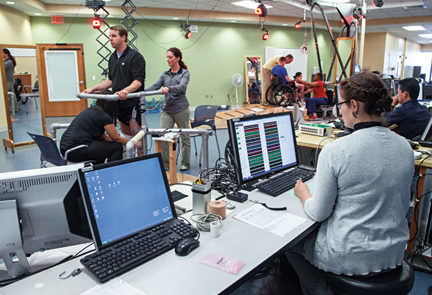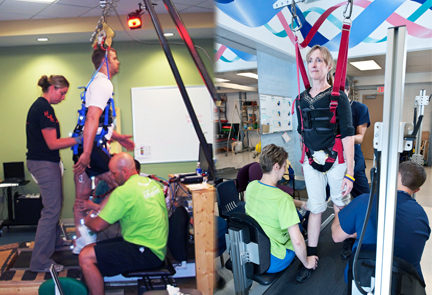 Stand Stimulation Stand Stimulation
The combination of lumbosacral spinal cord epidural stimulation and stand training is used to promote the recovery of standing after severe spinal cord injury. Epidural stimulation parameters are tailored for each research participant with the goal of facilitating the generation of continuous activation patterns of the lower limb muscles in response to weight bearing-related sensory information. Stand training is generally performed overground with different devices (i.e. a custom-built standing apparatus, walkers, and others) that can be used by the participant for balance assistance. Manual assistance for facilitating knee, hip, and trunk extension is provided by trainers only when needed. During stand training, both stable standing and dynamic tasks that involve body weight shifting and upper limbs movement are practiced. Epidural stimulation of the lumbrosacral spinal cord is used in combination with Locomotor Training (link to standard LT language) to promote recovery of stepping following spinal cord injury. Research participants train on a Body Weight Support Treadmill (BWST) and are provided with manual assistance when needed. Epidural stimulation in combination with task specific training is used to retrain the spinal cord to relearn the complex motor task of stepping. The combination of stimulation with appropriate sensory cues can lead to independent stepping and reduce the need for manual assistance from trainers. Participants can be transitioned to stepping overground without body weight support as part of the training strategy.
Epidural stimulation of the lumbrosacral spinal cord is used to facilitate movement of the legs and trunk following severe spinal cord injury. Isolation of toe, ankle and leg movements can be achieved with specific stimulation parameters. The research participants will practice these movements both in the laboratory and home environment with the goal of strengthening the connection between brain and spinal cord and promote recovery of the spinal networks intrinsic abilities. Epidural stimulation of the lumbosacral spinal cord can be used to increase blood pressure in individuals with severe spinal cord injury. Configuration of the electrode array can be modified to specifically target in systolic blood pressure and diastolic blood pressure, with modest decreases to heart rate. Once a configuration is found, individuals have the ability to utilize the stimulation in their home to maintain systolic blood pressure within a normative range (usually 105 mmHg to 120 mmHg). Cardiovascular effects last while the stimulator is being used, and the increases in blood pressure are repeatable from day-to-day. |
|



 Voluntary Movement Stimulation
Voluntary Movement Stimulation 


